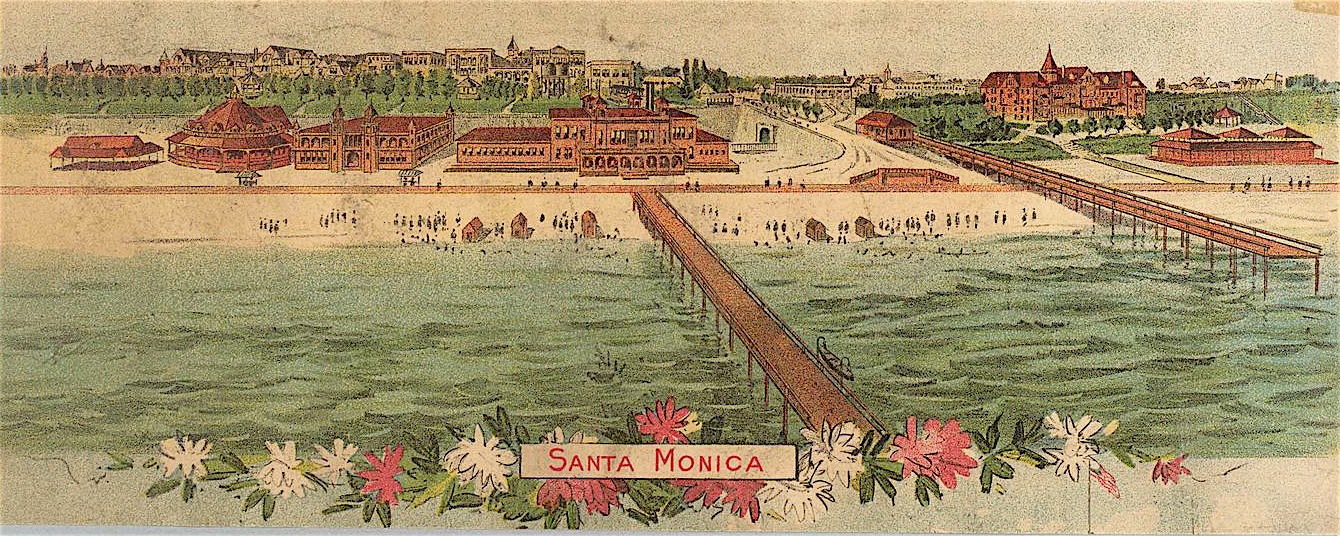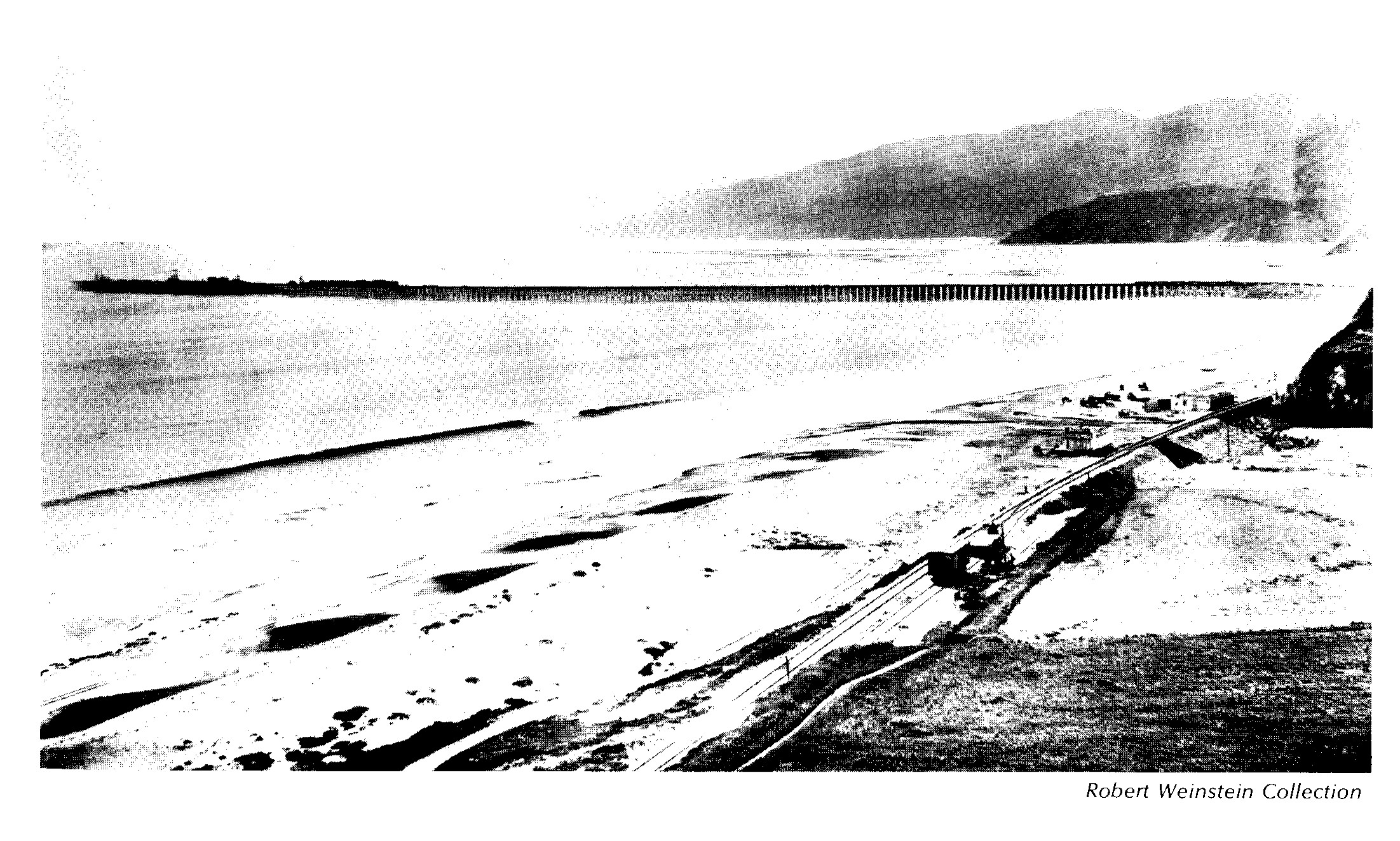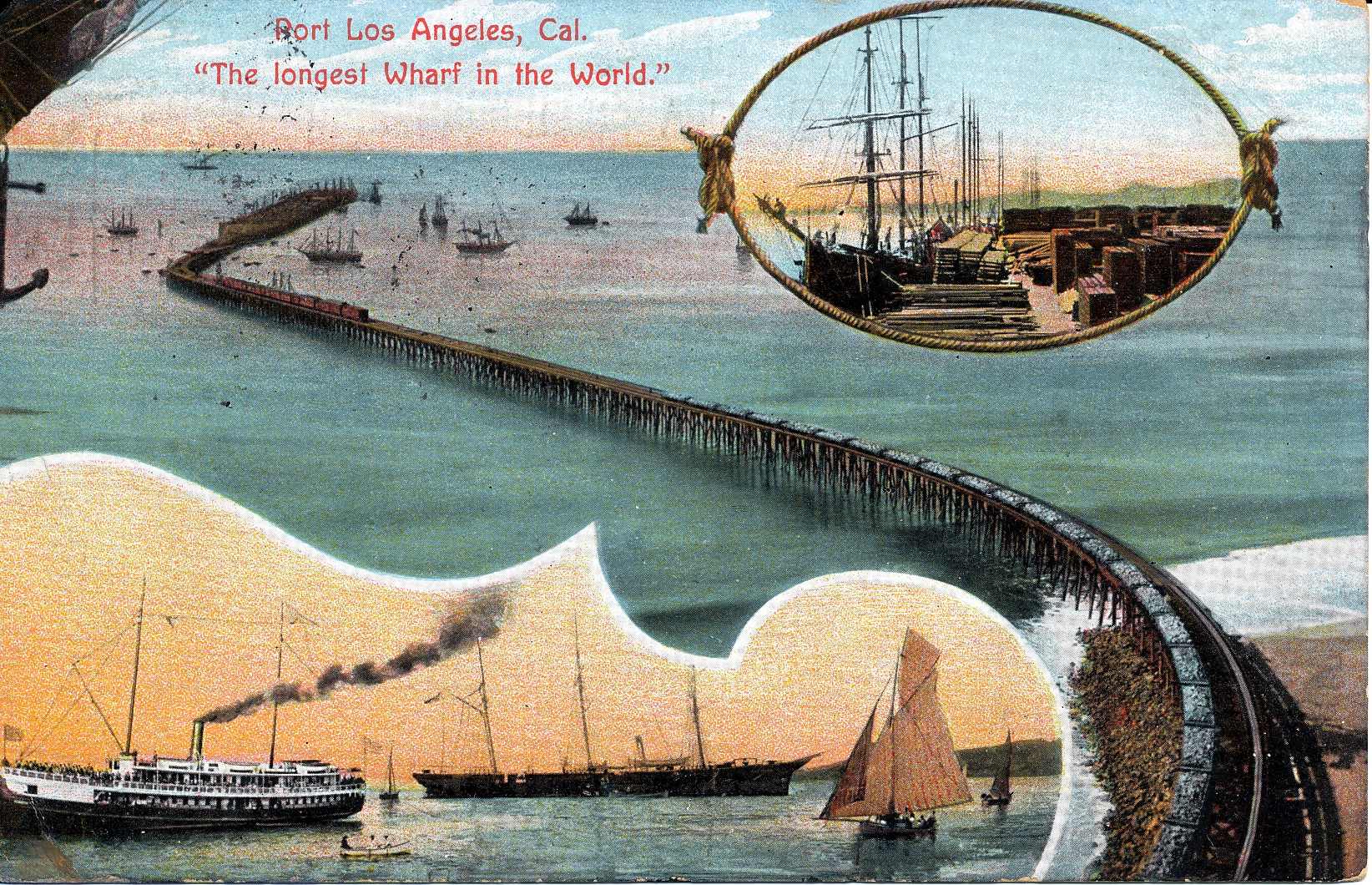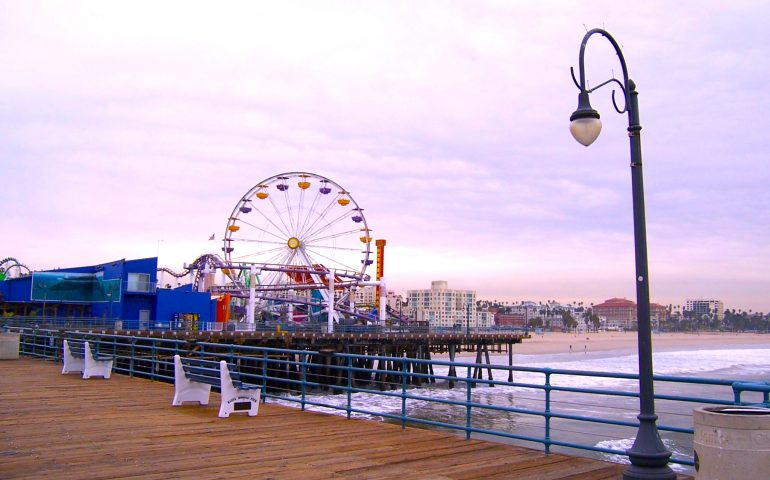Two of the most famous scenes featuring the pier in movies were in Forrest Gump and Titanic. In Forrest Gump, Forrest runs to the West Coast (and the Santa Monica Pier), turns around, and heads back east. In Titanic, Rose (Kate Winslet), now elderly, is seen standing on the deck of the salvage ship that has discovered the RMS Titanic in its north Atlantic grave. She takes out the “Heart of the Ocean,” the large blue diamond necklace that she had received the night of the sinking, and tosses it into the sea where her lover Jack (Leonardo DiCaprio) had died. Back in her room we see pictures from her life including a picture of her riding a horse at the Santa Monica Pier with the pier’s roller coaster in the background. The horse ride and coaster were destinations and activities that she and Jack had discussed.
The pier is also popular for TV: Victim of Love (1991 TV); Charlie’s Angels (TV); Marcus Welby, M.D (TV); Bay Watch (TV); Pacific Blue (TV); Gilmore Girls (TV); Murder, She Wrote (TV); The Cinnamon Cinder Show (1963 TV Series); If I Had a Million (1973 TV); Three’s Company (1977 TV); Casualties of Love: The Long Island Lolita Story (1993 TV); Comedy: Coast to Coast (1994 TV); Star Trek: Voyager (1995: Future’s End: Part 1 TV); The Amazing Race 2001 TV); The Five People You Meet in Heaven (2004 TV); The L Word (2004 TV); Amy Coyne (2006 TV).
Last but not least, the pier has shown up in some video games including Tony Hawk’s American Wasteland and Vampire: Bloodlines.
And—there are probably more of which I am unaware.
“A certain kind of ‘pier noir’ look emerged in Hollywood crime melodramas (such as Quicksand, Pitfall, and Fallen Angel), where the pier represented a seedy seaside haunt for desperate characters.”
—Harry Medved with Bruce Akiyama, Hollywood Escapes, 2006
Did You Know? That there is a drink named the Santa Monica Pier? The recipe is simple—6 oz Alize® liqueur and 2 oz triple sec. In a tall glass with ice, pour the Alize and Triple Sec, stir and enjoy.
Did You Know? That the man who had the lease for the Sportfishing operations on the pier in the ‘30s, Norwegian Captain Olaf C. Olsen, may have been the inspiration for the “Popeye” cartoon character? So claim some sources. Popeye’s creator, Elzie Crisler Segar, loved fishing and when his Thimble Theatre cartoon (with Olive Oyl and Harold Hamgravy) proved successful he moved to California settling into a house near the Santa Monica Pier. In 1929 he added Popeye to his group of characters and the rest is history. It isn’t clear whom Bluto and J. Wellington Wimpy represented.
Did You Know? The original “Hot Dog on a Stick” opened in 1946 on a sidewalk just south of the pier near what used to be Muscle Beach?
Did You Know? That folk star Joan Baez once lived in the Hippodrome above the Carousel on the pier? When she returned to pier in February 2009 she related how her and her friends would often as not sleep in beanbag chairs.
Did You Know? That Art Alexakis, the lead singer for Everclear, says he tried to commit suicide as a teenager by getting high on marijuana, filling his pockets with weights, and jumping off the Santa Monica Pier? He now claims the vision and voice of his deceased brother George led to his survival.
Did You Know? That Cirque du Soleil first played the Santa Monica Pier in 1987? That year they pitched a tent and commenced a run on the pier called We Reinvent the Circus. In 2009, the group returned to the pier for two anniversaries, their own 25th, and the pier’s 100th.
Did You Know? That though the Santa Monica Pier has long been noted (by many) as the western terminus for the famous Route 66, it just isn’t so? Route 66, aka U.S. Route 66, The Main Street of America, The Mother Road, and the Will Rogers Highway, dates to November 11, 1926 and originally ran from Chicago to downtown Los Angeles, a total of 2,448 miles. It was realigned in 1939 to end in Santa Monica at the intersection of Olympic Boulevard and Lincoln Boulevard (a segment of State Route 1). Although a Dedication Plaque for the Will Rogers Highway sits about a block away from the pier in Palisades Park—near the intersection of Santa Monica Blvd. and Ocean Avenue—neither the intersection nor the pier was the true end of the famous road.
Did You Know? That poaching for lobsters is an ongoing problem?
Hunting Fishy At The Pier —Undercover Busts Lobster Catchers In Santa Monica
SANTA MONICA—A typical balmy summer Saturday night at Santa Monica Pier—parents push babies in strollers, a casually dressed young couple listens to a folk-rock duo from Canada, fishermen line the railings, the Ferris wheel spins in the background. But the young couple are California Department of Fish and Game wardens, and some of the fishermen are snagging lobsters out of season.
One fisherman yanks up violently on his fishing pole. His terminal tackle consists of a sinker followed by a number of large treble hooks tied to the line. This is a snagging rig according to the wardens. Lobsters are out of season and snagging is an illegal method of take at any time.
DFG wardens Ronda Moore and Ryan Maki play the part of the young couple. They were classmates at the DFG’s warden-training academy two years ago. Moore has six pairs of handcuffs and a mini-Glock under her Windbreaker. Normally she patrols the Antelope Valley, but as warden resources are stretched thin, she and Maki, who patrols in Orange County, help out tonight. They also don’t look like game wardens, according to senior warden Jim Beckwith, who organized this operation.
“I like to work the city but like to get out of it, too,’” Moore says. She grew up a country girl in Woodland, near Sacramento. Moore says she hunted and fished all her life, so when she decided on a job in law enforcement, becoming a game warden was a natural choice. “We do it all,’” she says. “Every day is different.’”
According to Beckwith, who has patrolled the Santa Monica Pier for many years, sometimes the snagging operations can be quite sophisticated, with one person snagging the bugs, another helping land them, and a runner to dispose of the evidence. “Once I found lobsters in a baby stroller,’” Beckwith says. “I reached in expecting to find the lobsters and touched a baby’s leg. They had two lobsters in with the kid.”
Tonight, Beckwith sees a fisherman make a big set, reel in the line, then reach over and slip something into a paper bag. The wardens move in and check the bag. It contains a small male lobster.“It happens. You get caught,’” says the suspect, who was arrested, cited and released. He says he also landed six calico bass, all legal size. “It was a good night, but I should have gone home.’”
It’s not as good a night for the wardens. They cite only the one alleged snagger, although they manage to find several other illegal lobsters and toss them back into the water. The Canadian strums his guitar and sings a Rolling Stones classic for the audience: “You can’t always get what you want …’”
This applies to the fishermen, too. “It’s not that they’re not trying to snag lobsters,’” Beckwith says. “They’re just not very good at it.’
—Bill Becher, Los Angeles Daily News, September 5, 2002
History Note. The first local pier was built in the early 1870s in an area called the Shoo-Fly Landing. The pier was built as a loading point for asphaltum (tar) from the inland La Brea pits and of course the pier became the Shoo-Fly Pier. It was located just a few hundred yards south of today’s Municipal Pier.
In June of 1875 Santa Monica had a new port when the Shoo-Fly Pier was replaced on the same site by the 1,740-foot-long Los Angeles and Independence Railroad Wharf (also called the Santa Monica Wharf). On the bluff north of the pier the railroad built the Santa Monica Hotel. Soon steamers from San Francisco brought both passengers and cargo and the area was booming. By 1877 the area had a bathhouse and a beach pavilion and it was becoming a favorite of tourists from the Los Angeles area.
In February, trains of the Los Angeles & Independence Railroad began to leave Los Angeles at ten o’clock in the morning and five o’clock in the afternoon, and Santa Monica at eight and four o’clock, the Company deeming it a sufficient inducement to allow excursionists five or six hours to bath, fish, or picnic.
—Harris Newmark, Sixty Years in Southern California 1853-1913, 1916
However, for a variety of reasons, the railroad soon became unprofitable and it was sold to Southern Pacific in June of 1877. Southern Pacific, which also controlled a larger facility at the port in San Pedro, soon raised rates at the wharf. Naturally, usage of the pier dropped and soon a new story arose. Southern Pacific announced that the pier was unsafe; teredo worms had supposedly damaged the pilings. The pier was condemned in 1878. Although citizens protested and asked that the pier not be removed, most was removed in 1879. After removal it was discovered that the pilings had been fairly sound. Southern Pacific had preferred to send business south to their San Pedro port.
Although there was an initial business depression following the destruction of most of the wharf, the area rebounded with tourist business in the 1880s. In 1887 the elegant Arcadia Hotel opened. At the time it was built it was probably the finest resort type hotel on the coast. Among the hotels amenities (at least until the mid-1890s) was the now-shortened Santa Monica Wharf that set just a short distance north of the hotel. The wharf was used by guests and visitors. The wharf had become (by default) a pleasure pier.
Growth of the Los Angeles basin during the 1880s stimulated the call for a new deepwater port. Initially, Los Angeles and Southern Pacific favored San Pedro. Then, in 1889, the Santa Fe Railroad opened their wharf in Redondo Beach. The Redondo wharf was closer to San Francisco (still the most important city commercially in the state) and began to grab more and more of the Los Angeles (and Southern Pacific) business. Fighting back, Collis Huntington and the other owners of Southern Pacific announced plans to build a wharf in the north part of Santa Monica.

1898
On July 25, 1892, Southern Pacific began to drive piles for their “Long Wharf” located at the mouth of Potrero Canyon. The wharf extended out 4,720 feet and was both California’s longest oceanfront pier and the longest wooden pier in the world.
 The “Long Wharf”
The “Long Wharf”
When the wharf began operations, on May 11, 1893, it became the “Port of Los Angeles” and was known by that name for many years. The nearly-mile-long pier was huge; it included two sets of railroad tracks (standard width and narrow gauge) that branched into seven tracks at the 130-foot-wide seaward end. The end included a warehouse, coal bunkers, depot and unloading facilities, a baggage room and a restaurant. Out toward the end, a stairway led down to a platform and boathouse reserved for anglers and sailors.

Port Los Angeles
This magnificent, three-mile, deep-sea wharf is a splendid contribution to commerce, and, incidentally, invites and rewards a continuous line of anglers, desirous of tempting nobler game than can be captured in the surf.
—Wayside Notes On The Sunset Route, Southern Pacific Company, 1902
However, a “harbor war” soon erupted between San Pedro and Santa Monica. Finally, in 1897, Congress appropriated money for the construction of the San Pedro breakwater and harbor and the “Port of Los Angeles” was doomed. In 1910 Southern Pacific announced it was abandoning the Long Wharf. With the loss of shipping and revenue, the Long Wharf became mainly a tourist attraction. In 1916 it was reduced in size by half and made into a fishing pier. The remaining portion was removed in 1921 and eventually whatever remnants remained of the “Long Wharf” were lost to storms. Today a small plaque sits near the lifeguard headquarters at Will Rogers State Beach, 15100 W Pacific Coast Hwy 1 commemorating the wharf. In closing it simply reads, “Today, no trace remains of what was once the longest wooden pier in the world.”

Santa Monica brings back some good memories, especially when I would go with my younger nephew fishing under the restaurant at the end. Always caught something, even if the day sucked for other fishermen. Under the Mariasol, I have caught my fair share of black, walleye, shiner( not common) and rainbow perch alongside sargo, black croaker, sand and calico bass. Have also caught Bonito, mackerel, halibut, turbot, sharks and rays, and the odd eel or octopus and crabs. That pier has a lot depending on the season, though I have had some good luck with Corbina and yellowfin croakers on the north side in front of the arcade facing the breaker waves. Sand crabs and mussels are key. If you fish the middle part of the pier under the pilings on either north or south sides in the spring, one can get some solid sargo action off mussels, bloodworms, or ghost shrimp.